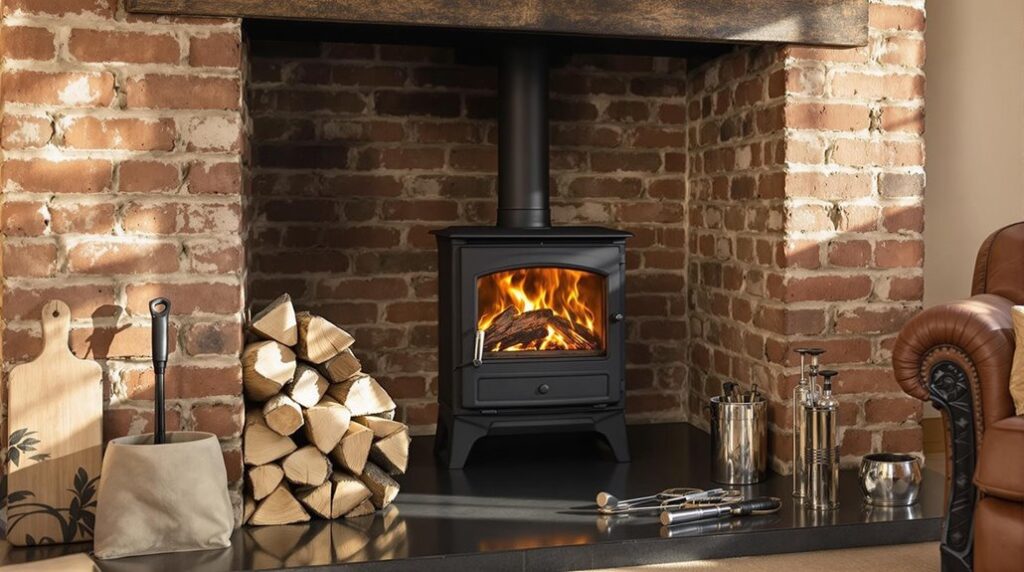I’ve helped dozens of homeowners navigate the complexities of converting gas fireplaces to wood stoves, and I can tell you the costs vary dramatically based on your existing setup. You’re looking at anywhere from £700 to £3,500, but that’s just the starting point. The real challenge isn’t the stove itself—it’s understanding which hidden expenses will apply to your specific situation and how to avoid the costly mistakes that catch most people off guard.
Key Takeaways
- Total conversion costs range from £700 to £3,500, with flue systems being the major expense at £800-£3,500.
- Gas Safe engineer disconnection plus HETAS-registered installer fees add £300-£700 to overall conversion costs.
- Wood stove purchase prices vary from £799 for entry-level models to over £7,151 for luxury options.
- Mandatory compliance requirements include chimney sweeping, smoke testing, and certifications costing £150-£600 additionally.
- Annual fuel costs range £100-£500, but potential savings of 40-60% compared to gas heating offer 3-5 year payback.
Overall Cost Breakdown for Gas to Wood Stove Conversion
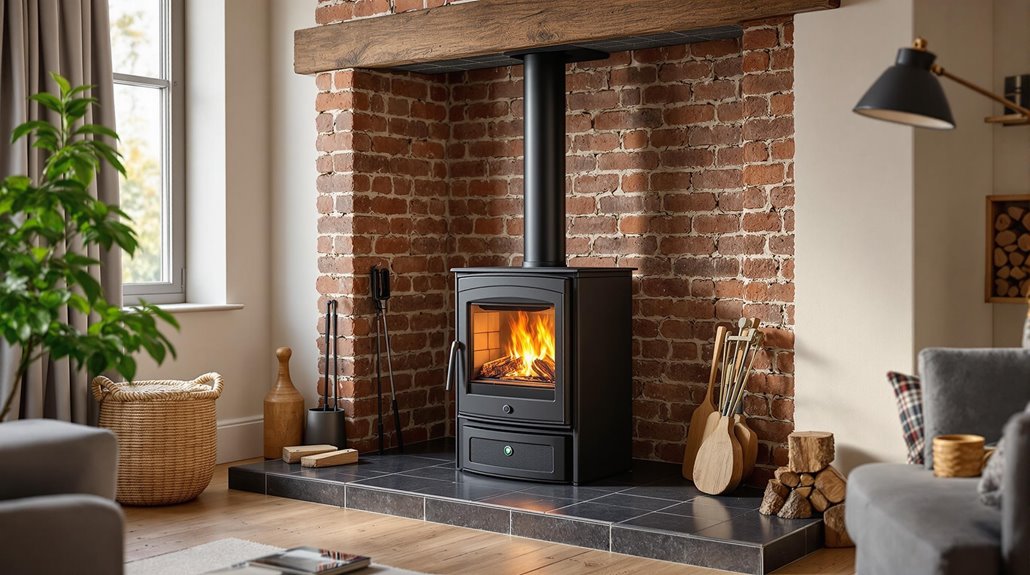
Converting a gas fireplace to a wood stove involves several cost components that’ll impact your total investment. I’ve found the average installation ranges from £700 to £3,500, but understanding the breakdown helps you budget effectively.
Your biggest expense will likely be the flue system. If you’re lining an existing chimney, expect £800-£1,500. Without a chimney, you’ll need a new twin-walled flue costing £1,500-£3,500.
Labour charges from HETAS-registered installers run £300-£700, while the stove itself costs £500-£1,500. You’ll also need a non-combustible hearth (£130-£200) and professional inspections (£50-£80).
Don’t forget ongoing costs like annual chimney sweeping at £50-£80. If you’re creating a new fireplace opening, add another £500-£2,000 to your budget. Remember that not all fireplaces are suitable for conversion, as size constraints may prevent proper stove accommodation and ventilation requirements.
Wood-Burning Stove Purchase Prices and Selection
The stove itself represents a considerable portion of your conversion budget, with prices varying dramatically based on design, materials, and output capacity. I’ll break down what you can expect across different price tiers.
Entry-level chamber stoves like the Cast Tec Nevis 5kW start at £799, while mid-range options such as the Chesneys Salisbury 5kW cost £1,719. If you’re drawn to contemporary freestanding designs, expect £2,469–£5,336 for models like the Chesneys Solstice. Additionally, it’s essential to consider the long-term savings that a more efficient wood-burning stove can provide compared to traditional heating methods.
Premium inset stoves with guillotine doors, including the Kalfire W85/40F, average £4,626. Luxury options like the Stuv 22/110 exceed £7,151.
Your choice impacts more than aesthetics—5kW models suit most UK living rooms, while larger outputs command higher prices. For reference, an average room size of 12m² typically requires a stove of 2kW to 5kW output capacity. Higher efficiency ratings and advanced features like airwash systems increase costs considerably.
Chimney and Flue System Installation Costs
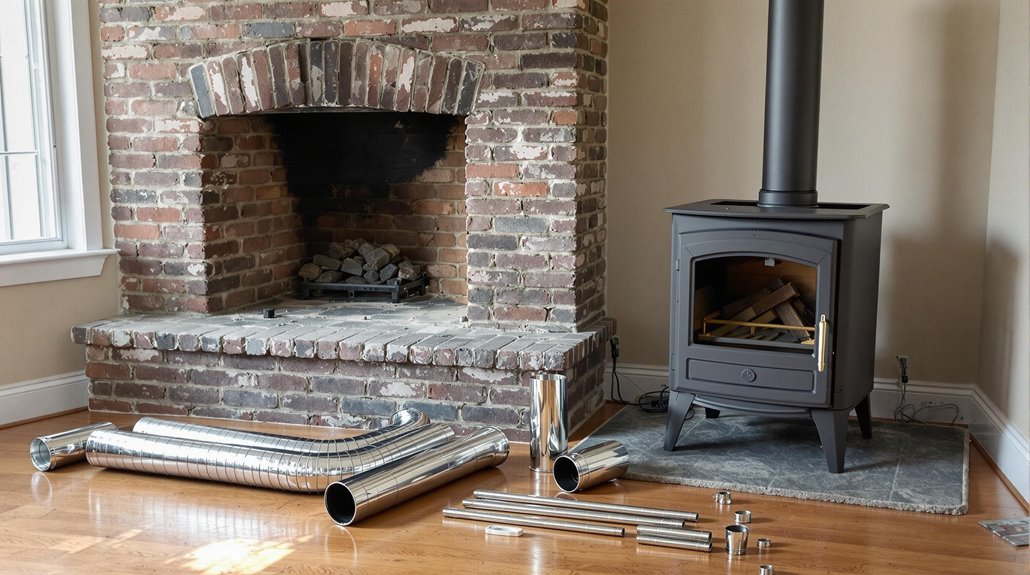
Beyond purchasing your stove, you’ll face considerable costs for chimney and flue system installation—often the most expensive component of your conversion project. I’ve found that flue installation for single-storey setups typically costs £700-£1,000, while total chimney systems can reach £2,000 with additional materials.
If you’re working with an existing chimney, you’ll spend £700-£2,000 total. However, installing a completely new chimney or flue pushes costs to £1,500-£3,500. For existing chimneys requiring new flue installation, expect to pay an average £1,150 for the work. Materials alone range from £1,000 upward, with labour starting at £650-£700.
Twin wall flue systems are essential when there’s no existing chimney, costing £700-£2,000 depending on complexity. The building’s height, accessibility, required bends, and building regulations compliance all impact your final bill considerably.
Professional Labour Fees and Certified Installation
When converting your gas fireplace to a wood stove, you’ll need certified professionals to handle critical safety aspects of the project. A Gas Safe engineer must disconnect your existing gas supply, while a HETAS-registered installer handles the wood stove installation. These certifications aren’t optional—they’re essential for safety and regulatory compliance.
You’re looking at labour costs ranging from £300-£700 for these certified professionals. This investment protects you from potential insurance issues and building code violations that could arise from uncertified work. The gas disconnection is your first step, requiring the Gas Safe engineer’s expertise before any stove installation begins.
Your HETAS installer will handle the actual stove fitting, ensuring proper positioning, flue connections, and safety clearances. These professionals understand the technical requirements that keep your family safe. The installation process involves removing gas components and installing wood-burning parts, making professional assistance highly recommended for the complexity of the conversion.
Essential Materials and Component Expenses
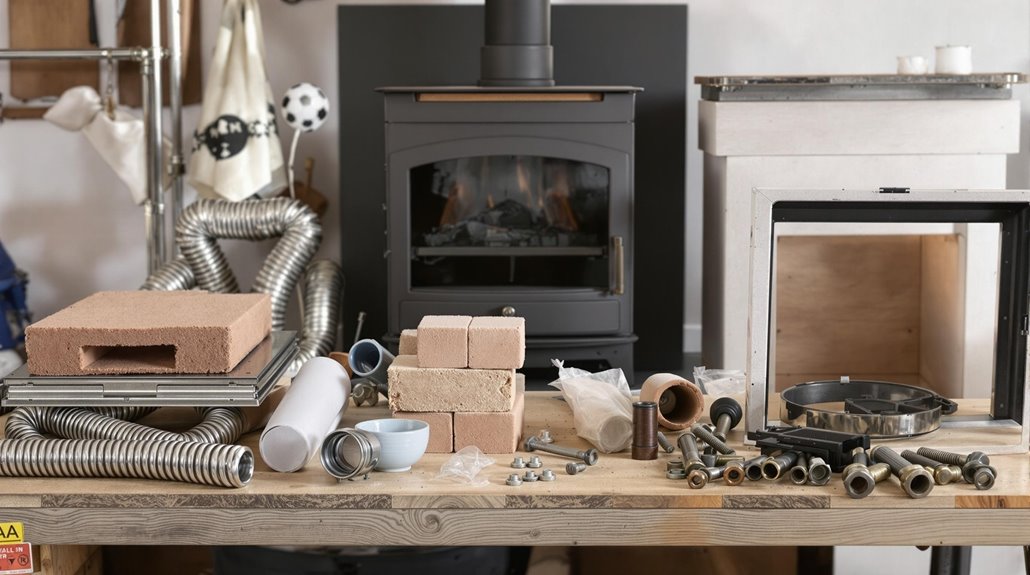
Converting your gas fireplace requires purchasing several essential components, with your wood stove unit representing the largest single expense. I’ll break down what you’re looking at cost-wise.
Your stove unit will run £500–£1,500 depending on material and efficiency. Cast iron models typically cost £800–£1,200, while steel versions average £500–£900. DEFRA-approved units add 15–20% to base costs.
You’ll need a chimney lining system, costing £800–£1,500 installed. If there’s no existing chimney, twin-walled flue systems run £1,500–£3,500. A chimney liner may be necessary for safety reasons to prevent carbon monoxide entry into your home.
Essential safety components include non-combustible hearth materials (£130–£200), carbon monoxide detectors (£20–£40), and flue pipes (£50–£120 per metre). Don’t forget ventilation requirements and wall protection panels.
Building Regulations and Safety Compliance Requirements
While purchasing the right components forms the foundation of your conversion project, you’ll face significant regulatory hurdles that can derail your timeline and budget if overlooked. I’ll guide you through the essential compliance requirements that determine your project’s legality and cost.
You’ll need HETAS certification or Building Control notification before starting work. HETAS installers self-certify and issue compliance certificates, while non-certified installations require local authority inspections that add £300-600 to your budget. Your hearth must meet strict dimensions—minimum 840x840mm with 300mm front extension and 150mm side clearances. Additionally, ensure your installation adheres to recommended installation heights for optimal safety.
Pre-installation chimney sweeping and smoke pellet testing are mandatory, costing £150-250. In Smoke Control Areas, you’ll need DEFRA-approved stoves only. Post-installation documentation including compliance certificates protects your insurance validity and property value. Your installation work must comply with multiple Building Regulations including Approved Documents F, J, L, G, and P to ensure safety and efficiency standards are met.
Annual Maintenance and Long-Term Operating Costs
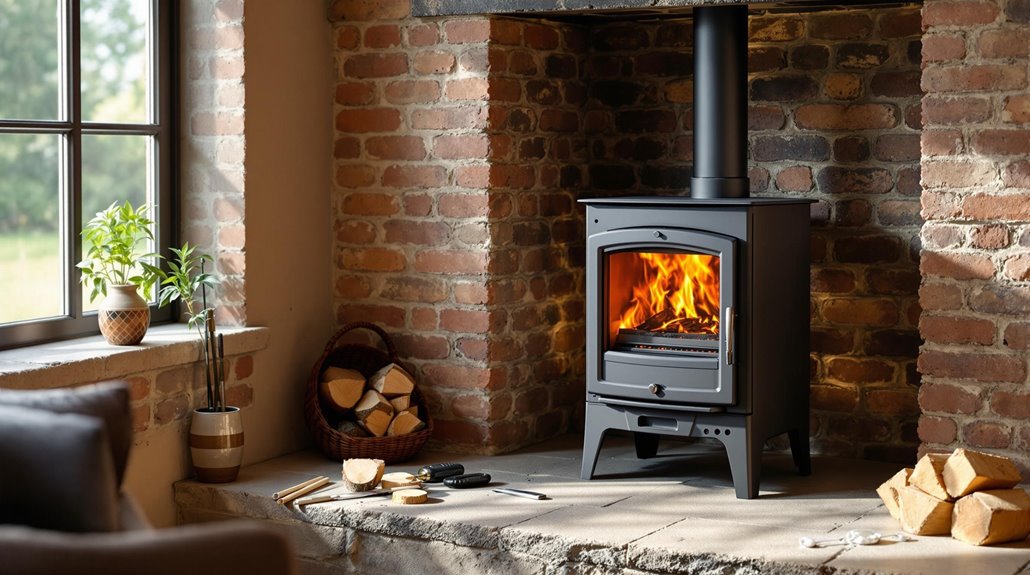
Annual servicing runs £70-£150 and isn’t optional—it’s required for safety and efficiency. Your insurance likely depends on it. Chimney sweeping costs £50-£100 yearly, preventing dangerous blockages that reduce efficiency by 20%. Wood stoves are designed for owner maintenance, allowing you to handle basic upkeep tasks yourself and reduce overall costs. Additionally, proper home insulation can significantly enhance the overall efficiency of your heating system and lower your energy bills.
Fuel represents your biggest ongoing expense. Quality kiln-dried wood costs £100-£150 per cubic metre, while cheaper seasoned wood runs £60-£80 but burns less efficiently. Most households spend £100-£500 annually on fuel.
Replacement parts add up: fire bricks (£30-£60), door glass (£40-£120), and baffle plates (£50-£150). However, you’ll potentially save 40-60% versus gas heating, achieving payback within 3-5 years.
Conclusion
Converting your gas fireplace to a wood stove represents a significant upfront investment of £700-£3,500, but I’d recommend viewing it through a cost-benefit lens. You’ll likely recover your investment within 3-5 years through 40-60% heating bill reductions. Focus on obtaining certified installation to meet building regulations and factor in annual maintenance costs. Calculate your specific heating usage patterns to determine if this conversion makes financial sense for your situation.
References
- https://www.flue-pipes.com/info/how-to-convert-a-gas-fireplace-into-a-wood-burner
- https://www.mumsnet.com/talk/property/4725494-cost-to-remove-gas-fire-and-install-wood-burner
- https://chesneys.co.uk/installing-a-wood-burning-stove-in-an-existing-fireplace
- https://www.directstoves.com/our-blog/the-ultimate-guide-to-wood-burning-stove-installation-costs-in-2023/
- https://www.checkatrade.com/blog/cost-guides/log-burner-install-cost/
- https://www.homefire.co.uk/blog/log-burner-installation-cost-in-2025-what-to-expect.html
- https://www.flamecrafters.co.uk/blogs/news/log-burner-installation-cost
- https://www.myjobquote.co.uk/costs/installing-a-log-burner
- https://www.tulipalo.co.uk/blog/wood-burning-stove-installation-cost-guide/
- https://heatable.co.uk/boiler-advice/wood-vs-gas-heating

